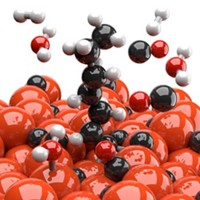Advertisement
Grab your lab coat. Let's get started
Welcome!
Welcome!
Create an account below to get 6 C&EN articles per month, receive newsletters and more - all free.
It seems this is your first time logging in online. Please enter the following information to continue.
As an ACS member you automatically get access to this site. All we need is few more details to create your reading experience.
Not you? Sign in with a different account.
Not you? Sign in with a different account.
ERROR 1
ERROR 1
ERROR 2
ERROR 2
ERROR 2
ERROR 2
ERROR 2
Password and Confirm password must match.
If you have an ACS member number, please enter it here so we can link this account to your membership. (optional)
ERROR 2
ACS values your privacy. By submitting your information, you are gaining access to C&EN and subscribing to our weekly newsletter. We use the information you provide to make your reading experience better, and we will never sell your data to third party members.
Synthesis
New Way To 'Fix' CO2
Electrocatalysis: Process converts CO2 in air into the useful organic feedstock oxalate
by Stu Borman
January 18, 2010
| A version of this story appeared in
Volume 88, Issue 3

In a study with implications for addressing global warming, researchers have devised a new way to remove the greenhouse gas CO2 from air and form a useful organic feedstock in the process (Science 2010, 327, 313). The technique is still at the demonstration stage but has promising advantages over other CO2 sequestration strategies.
Previously devised processes for “fixing” CO2 include stoichiometric reactions with hydroxide to form carbonate or bicarbonate and catalytic transformations to form organic compounds such as formaldehyde and methanol. Catalytic conversion is more efficient and practical for large-scale use, but current catalysts can’t be used on CO2 in air because they also reduce oxygen, which is present in air at vastly higher levels than CO2. In addition, they are unselective, creating mixtures of organic products.
Inorganic chemist Elisabeth Bouwman of Leiden University, in the Netherlands, and coworkers have now developed a catalyst that reacts with CO2 from ambient air to form a single product: oxalate, a useful feedstock for production of methyl glycolate and other organic compounds. After the reaction, the catalyst is regenerated electrochemically at a very low reduction potential, meaning it is unusually favorable energetically.
The process won’t ameliorate the global warming problem right away—and maybe never will. “Our study is purely fundamental, and the findings will need a lot of additional work before they could possibly be applied in an industrial setting,” Bouwman notes.
Nevertheless, “it’s amazing” that this catalyst reduces CO2 preferentially over oxygen and that the electrochemical step requires so little energy—suggesting that “the catalyst’s structure is almost perfectly matched to the reaction it’s driving,” comments Clifford P. Kubiak of the University of California, San Diego, a specialist in CO2 conversion. Compared with other ways to remove CO2 from air, converting the greenhouse gas to oxalate catalytically, efficiently, and selectively “is near the top of the desirability rankings,” he says.]




Join the conversation
Contact the reporter
Submit a Letter to the Editor for publication
Engage with us on Twitter